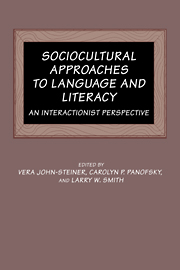Book contents
- Frontmatter
- Contents
- List of contributors
- 1 Introduction
- Part 1 Context
- 2 An interactionist approach to the analysis of similarities and differences between spoken and written language
- 3 Repair in spontaneous speech: A window on second language development
- 4 Struggling for a voice: An interactionist view of language and literacy in Deaf education
- Part II Mediational processes
- Part III Functional systems
- Author index
- Subject index
2 - An interactionist approach to the analysis of similarities and differences between spoken and written language
Published online by Cambridge University Press: 05 November 2011
- Frontmatter
- Contents
- List of contributors
- 1 Introduction
- Part 1 Context
- 2 An interactionist approach to the analysis of similarities and differences between spoken and written language
- 3 Repair in spontaneous speech: A window on second language development
- 4 Struggling for a voice: An interactionist view of language and literacy in Deaf education
- Part II Mediational processes
- Part III Functional systems
- Author index
- Subject index
Summary
INTRODUCTION
An interactionist approach to the analysis of similarities and differences between spoken and written language is a social and functionalist approach that has its basic theoretical underpinnings in L. S. Vygotsky's conception of language development. For Vygotsky, each individual's language development originates in social interaction, and then language development and social interaction continue a mutually mediating and transforming relationship within the semiotic system of the given culture. Various authors have referred to the Vygotskian approach as “sociohistorical.” Ochs (1984, p. 327), as one example, has defined the sociohistorical approach to language development and use as acknowledging the need in language studies to
examine closely the organization of language activities, including the verbal means used to achieve goals, the sequential organization of verbal means, and the contexts in which goals, means, and sequential orders are taken up by language users, and relate these organizational patterns to cognitive skills and to systems of belief and social order.
It is possible to use the term “interactionist” to refer to several different levels of analysis: (1) In its broadest sense, “interactionist” refers to the Vygotskian conception of the “unification of nature and culture in the course of ontogenetic development” (John-Steiner and Tatter, 1983, p. 95) as opposed to either nativist or behaviorist conceptions of human development. (See also Wertsch, 1985a, 1985b; and Scinto, 1986). (2) In a second sense, “interactionist” refers to the use of language as social action and the understanding of language as based in human interaction in the various contexts available in the social semiotic of a given culture.
- Type
- Chapter
- Information
- Sociocultural Approaches to Language and LiteracyAn Interactionist Perspective, pp. 43 - 81Publisher: Cambridge University PressPrint publication year: 1994



